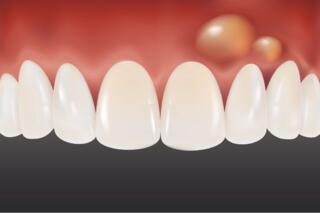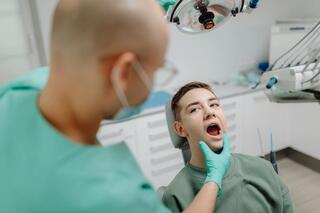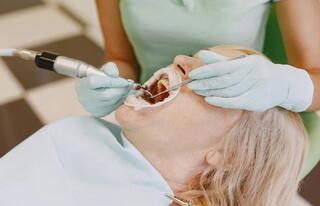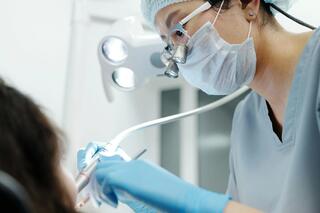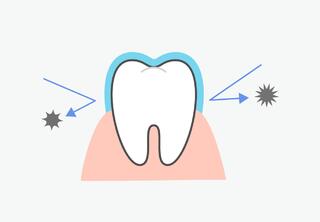Lump on the Gum – What It Is
A lump on the gum is a swelling on the gum that can be small or noticeable and may indicate various conditions. These lumps are often associated with infections from bacteria or mechanical damage. They can be either painful or painless. Lumps may signal gum diseases, such as gingivitis or periodontitis. It's crucial to consult a dentist promptly for diagnosis and treatment. Some lumps may disappear on their own, while others require a specialist's intervention.
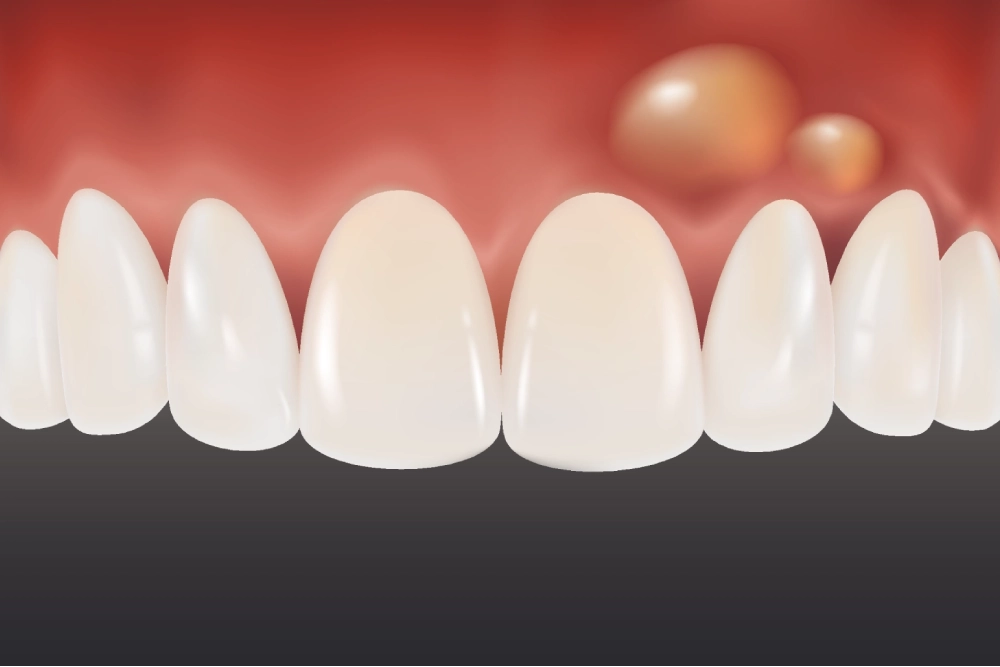
Causes of a Lump on the Gum
The appearance of a lump on the gum is always linked to a pathological process.
The origin of the lump can be:
- Non-infectious: The swelling arises from mechanical, thermal, or chemical impact on the tissue.
- Infectious: Inflammation due to the activity of pathogenic bacteria, often due to poor oral hygiene.
Lumps rarely occur due to the eruption of teeth or the growth of the jawbone (exostosis). Risk factors also include benign and malignant tumors of the oral cavity.
Does a Gum Lump Hurt?
Gum lumps do not always cause pain. Local sensitivity is typically absent when the swelling results from a non-infectious process. In certain situations, the pain may be more general:
- When periodontal tissue is mechanically damaged, it might feel like the entire affected area hurts.
- The eruption of baby teeth often causes considerable pain, while permanent teeth grow almost without pain.
- The pain from malignant tumors only manifests in the second and subsequent stages.
If an infectious process causes the lump, the patient usually experiences pain.
When Does the Lump Hurt?
- Gingivitis is the initial stage of gum tissue inflammation. Lumps form on the gum in the hypertrophic form of the disease. Pain occurs during tooth brushing and chewing.
- Periodontitis is the inflammation of the periodontium (the ligament apparatus holding the tooth). Pain arises when pressing on the formation that emerges in the case of purulent inflammation. White lumps appear just below the gum line.
A clear sign of periodontitis is tooth sensitivity to pressure. However, if the pus has drained, vertical pressure may not cause pain. This condition is extremely dangerous as the spread of the infection can lead to tooth loss. An urgent visit to the dentist is necessary.
- Periostitis or "flux" causes the painful swelling to increase or decrease in size. The "sack" often contains purulent content. In advanced stages, the pain becomes sharp and throbbing.
- A radicular cyst, in advanced cases, the cyst's walls become inflamed, forming a painful, purulent lump that hurts upon pressure. Symptoms include weakness, fever, and chills.
When Does the Lump Not Hurt?
- Gum fistula: An infectious formation that looks like a pink lump with a white spot in the center. Since the pus exits through a canal between the gum and the inflammation, the patient does not experience discomfort and pain.
- Exostosis: Benign growths on the jawbone. No pain is felt when pressed. The pathology can be diagnosed with an X-ray.
- Epulis: A fungus-like lump on the gum. It forms after an injury from wearing an incorrect prosthesis or due to a bite anomaly. Pain is only felt when the lump is injured.
- Hematoma: A formation under the tooth due to damage to the blood vessels during treatment or removal of a tooth. A hematoma does not hurt and resolves on its own.
When there is no pain, patients often delay visiting the dentist, even if they detect a lump in their mouth. In such cases, the opportunity to save the tooth may be missed. The spread of infection can lead to the need to remove the tooth and increases the risk of inflammation spreading to healthy tissues and teeth.
Treating a Lump
Diagnosis and treatment depend on the cause of the condition. Diagnostic measures include:
- When periodontal tissue is mechanically damaged, it might feel like the entire affected area hurts.
- examination and interviewing the patient;
- X-ray imaging;
- tissue biopsy if necessary.
Based on the diagnostic information, the dentist selects the treatment method.
| Pathology | Treatment | Treatment Prognosis |
|---|---|---|
| Fistula | Rinsing with Chlorhexidine, Miramistin, or saline solution. Excision of the formation if indicated. | Depends on the location, type, and duration of the fistula's existence. Complete recovery often follows removal. |
| Epulis | Surgical intervention - removal of the formation using diathermocoagulation, cryodestruction, or scalpel. | Favorable. The risk of recurrence is high only if the cause of the pathology is incorrectly identified. |
| Periodontitis | Removal of filling, canal cleaning, draining pus, anti-inflammatory mouth baths. | Favorable with timely medical consultation. |
| Gingivitis | Professional teeth cleaning, prescribing anti-inflammatory drugs. | Excellent. Simple clinical situation. |
| Parodontitis | Cleaning of periodontal pockets, antibacterial treatment, removal of the formation. | Favorable when treated at an early stage. In advanced cases, there is a high risk of developing periodontitis and tooth loss. |
| Periostitis or "flux" | Placement of special medications under a temporary filling. If therapy is ineffective, the tooth is removed. | Favorable. In rare cases (with a weakened immune system), the disease becomes chronic - osteomyelitis of the jawbone develops. |
| Exostosis | Surgical removal of the formation. Small sizes may be treated with laser burning. | In most cases, the problem is resolved quickly and without issues. |
| Cyst | Excision of the gum lump, antibacterial baths during the rehabilitation period. | Favorable. However, recurrence is not excluded. |
Prevention
Prevention involves timely dental treatment and regular oral hygiene.
Recommendations:
- brush teeth and tongue twice a day;
- use dental floss;
- apply mouthwash after eating;
- use an irrigator to remove plaque;
- undergo professional cleaning every six months.
Balanced nutrition also prevents the formation of lumps on the gums. The daily diet should include foods rich in calcium, phosphorus, vitamins D, K, and C.
Frequently Asked Questions
Why does a lump appear on the gum?
Lumps on the gum can arise due to infections, poor oral hygiene, injuries, allergic reactions, or gum diseases.
Is a gum lump painful?
It depends on the cause. Lumps caused by infection or inflammation are often painful.
How do you treat a gum lump?
Treatment depends on the cause. It may include antibiotics, antiseptic rinses, surgical intervention, or treatment of the underlying disease.
Can a gum lump be dangerous?
In some cases, yes, especially if it's related to an infection or a malignant growth.
How can you prevent gum lumps?
Regular oral hygiene, healthy eating, avoiding injuries, and regular dental visits can help prevent their occurrence.
Should you see a doctor if you have a lump on your gum?
Yes, it's important to consult a dentist to determine the cause and appropriate treatment. A periodontist specializes in gum treatment. If such a specialist is not available at the clinic, a general dentist can help.
I have a bump on my gum after getting a crown - what should I do?
A growth on the gum can result from an improperly made or installed prosthesis. You should consult your dentist. It may be necessary to remove the crown and redo the prosthesis.
